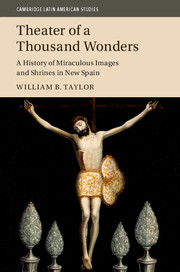Book contents
- Frontmatter
- Dedication
- Contents
- List of Figures
- List of Maps
- List of Tables
- Preface and Acknowledgments
- Archive Abbreviations
- Introduction
- Part I Bearings: Historical Patterns and Places of Image Shrines
- Part II Soundings: Divine Presence, Place, and the Power of Things
- Conclusion
- Appendix 1 Colonial Image Shrines
- Appendix 2 When Shrines Began
- Appendix 3 Other Saints
- Index
Appendix 3 - Other Saints
Published online by Cambridge University Press: 05 September 2016
- Frontmatter
- Dedication
- Contents
- List of Figures
- List of Maps
- List of Tables
- Preface and Acknowledgments
- Archive Abbreviations
- Introduction
- Part I Bearings: Historical Patterns and Places of Image Shrines
- Part II Soundings: Divine Presence, Place, and the Power of Things
- Conclusion
- Appendix 1 Colonial Image Shrines
- Appendix 2 When Shrines Began
- Appendix 3 Other Saints
- Index
Summary
Few images of saints other than the Blessed Mary became widely renowned as miraculous in New Spain. Of course, virtually every saint – and some exemplary Christians not destined for sainthood – had followers, and every image of a saint might take on the aura of immanence since miraculous power was by definition an attribute of sainthood. A few shrines and images of saints did gain fame beyond the local community, and even an obscure saint like San Félix Papa could become the outstanding divine protector of an important town. But only the colonial shrine of San Miguel del Milagro in Tlaxcala gained a regional following comparable to Marian shrines like Zapopan, Xuquila, Izamal, and El Pueblito; and it fell short of the reach of the great shrines to the Virgin of Guadalupe at Tepeyac, the Virgin of the Immaculate Conception at San Juan de los Lagos, the Christ of Chalma, and the Christ of Esquipulas.
How and when the saints and their images became widely known and venerated during the colonial period is not altogether clear. While emphasizing that “no other aspect of Christian belief and ritual had a remotely comparable impact on the broad range of [Nahua] activity” in central Mexico during the colonial period, James Lockhart suggests that the saints only gradually “seeped” into Nahuas’ devotions, mainly through the influence of Spanish lay settlers beginning in the late sixteenth century. However, European influences by and large favored earlier promotion and enthusiasm for saints despite some constraints in the first generations of colonization. Devotional reforms of the time, both before and after the Council of Trent decrees (1546–1563), tended to promote episcopal and papal authority and universal features of the faith at the expense of the local and eccentric, inevitably affecting the cult of saints, which was so important to Christian devotion in Europe during the late Middle Ages. The calendar of saints was pruned back by the reformers, and no new saints were recognized between 1523 and 1588, but the cult of saints and their images still flourished within a more restricted, hierarchical order that featured canonized heroes of the New Testament and the leading religious orders, and early Christian martyrs.
- Type
- Chapter
- Information
- Theater of a Thousand WondersA History of Miraculous Images and Shrines in New Spain, pp. 604 - 638Publisher: Cambridge University PressPrint publication year: 2016

